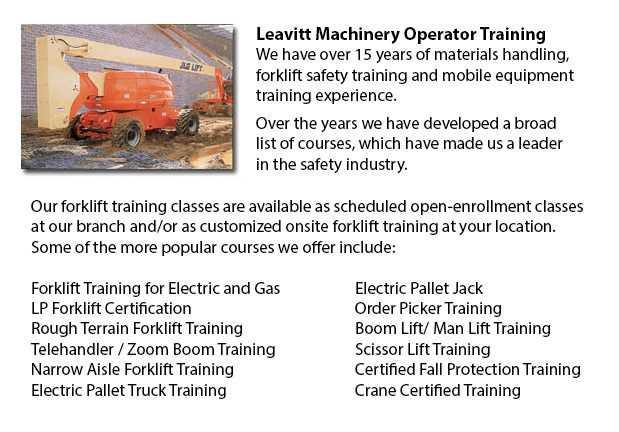
Aerial Boom Lift Training Saskatoon - For individuals who operate or supervise the use of aerial lift platforms, proper aerial boom lift Training is required. The aerial lift platform is for lifting people, tools and materials to elevated work locations. They are normally used to access utility lines and other above ground job-sites. There are different kinds of aerial booms lifts, such as articulating boom lifts, extension boom lifts and cherry pickers. There are two types of boom lift: "knuckle" and "telescopic".
Training in the essential equipment, safety and operations issues involved in boom lifts is important. Employees have to understand the safe work practices, rules and dangers while working among mobile equipment. Training program materials provide an introduction to the uses, terminology, skills and concepts necessary for workers to obtain competence in operating boom lifts. The material is aimed at workers, equipment operators and safety professionals.
This training is adaptive, cost-effective and educational for your business. An effective and safe workplace can help a company attain overall high levels of production. Less workplace incidents occur in workplaces with strict safety guidelines. All equipment operators have to be trained and assessed. They need knowledge of present safety measures. They need to comprehend and adhere to rules set forth by the local governing authorities and their employer.
Employers should make sure that their workers who operate aerial boom lifts get proper training in their safe use. Operator certification is required on every different kind of aerial machine utilized in the workplace. Certifications are available for aerial work platforms, articulating booms, scissor lifts, industrial forklift trucks, and so forth. Employees who are completely trained work more efficiently and effectively compared to untrained employees, who need more supervision. Proper training and instruction saves resources in the long run.
The best prevention for workplace deaths is correct training. Training can help prevent electrocutions, falls and tip overs or collapses. Other than obtaining the necessary training, workplace accidents could be better avoided by using the aerial work platforms based on the instructions of the manufacturer. Allow for the combined weight of the worker, tools and materials when adhering to load limitations. Never override mechanical, electrical or hydraulic safety devices. Workers should be held securely in the basket making use of a body harness or restraining belt with a lanyard attached. Do not move lift equipment whilst employees are on the elevated platform. Employees should take care not to position themselves between the basket rails and beams or joists in order to avoid being crushed. Energized overhead power lines must be at least 10 feet away from the lift machinery. It is recommended that workers always assume wires and power lines may be energized, even if they are down or appear to be insulated. Set the brakes and make use of wheel chocks if working on an incline.
-
Scissor Lift Safety Training Saskatoon
Scissor Lift Safety Training Saskatoon - A scissor lift is a type of platform lift that moves vertically. The lift table is moved in a vertical motion because of criss-cross folding supports that are linked in what is called a pantograph. The platfor... More -
Crane License Saskatoon
Crane License Saskatoon - The operator of a crane has to have been certified with a crane operator license or certification. In order to practice as a crane operator, the credentials are considered mandatory. Licensing consists of training and final... More -
Order Picker Training Saskatoon
Order Picker Training Saskatoon - Order picker's allows warehouse staff to lift pallets making use of forks. Likewise known as a stock picker, this particular electrically-powered machinery is like a forklift except that an order picker is also made... More -
Scissor Lift Training Saskatoon
Scissor Lift Training Saskatoon - While operating a scissor lift, they have to be used competently so as to protect the wellbeing of the other employees inside the workplace and to protect the safety of the equipment. Skilled operators are trained to... More -
Telehandler Training Courses Saskatoon
Telehandler Training Courses Saskatoon - Employers are responsible for making certain that their operating personnel and supervisors are trained to work proficiently utilizing telehandler equipment. The skill level of employees need to be assessed. I... More -
Narrow Aisle Forklift / Order Picker Training / Electric Pallet Jack / Electric Pallet Truck Training in Saskatoon
A pallet jack is an appliance built especially for transporting pallets of differing weights and dimensions. They may be used in conjunction with cranes, forklifts and other heavy duty machinery as an attachment piece or to be used on their own. Pall... More -
Boom Lift Operator Training Saskatoon
Boom Lift Operator Training Saskatoon - A cherry picker refers to a type of aerial work platform. Cherry pickers include a bucket or platform at the hydraulic lifting system's end. The machine is also known as a man lift, boom lift, basket crane or h... More -
Aerial Platform Training Saskatoon
Aerial Platform Training Saskatoon - Aerial forklifts can be utilized to accomplish several distinctive tasks done in hard to reach aerial places. Some of the tasks associated with this style of lift include performing routine maintenance on building... More

Forklift Training Saskatoon
TOLL FREE: 1-888-254-6157
Saskatoon, Saskatchewan
forklifttrainingsaskatoon.com
Email Us
About Us



